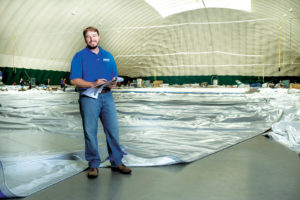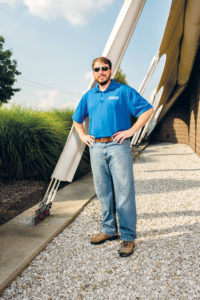Eric Heischmidt approaches project management with flexibility and an architect’s eye for precision.

“Project management means planning ahead,” says Eric Heischmidt, senior project manager, Arizon Structures, St. Louis, Mo. “But more than anything it means being prepared to be flexible, because every project is an evolution. Things change, and you need to react to those changes and keep things moving in a forward direction.”
Heischmidt began his career working as an architect with a firm in St. Louis, and when the economy took a turn for the worse in 2008 and many construction projects evaporated, he began to explore other options. He landed a position as a project manager at Arizon Structures—a company that had recently expanded its reach to include designing, manufacturing and installing air-supported structures. “One of the things that drew me to the company was that I could see that the fabric building industry had potential to be more recession-resilient compared with conventional construction types.”
In college, Heischmidt had some exposure to fabric clearspan structures but had not participated in any fabric architecture projects while working as an architect. Since coming on board with Arizon, however, he’s become somewhat of an expert on the applications and benefits of air-supported structures. “Air-supported structures are by far the most economical way to cover a clearspan space,” he says. “There are a lot of big sports projects that started as brick-and-mortar arenas or complexes that proved not to be feasible for the owners to develop the project. Air-supported structures provide a much more economical means for an indoor sports facility than a clearspan steel structure, for example. So in that way a lot of owners and developers were able to keep their projects going using fabric buildings.”
Because the air-supported structures division was only a few years old when Heischmidt started at the company, it allowed him opportunities to develop his project management skills quickly. He started out by managing two or three projects at a time. Now, as senior project manager, he oversees a number of managers and all of the projects the company does for air-supported structures. His responsibilities include the successful delivery of projects from the time they become a sale through design, manufacturing and implementation; delivery to the job site and job site installation, through owner close-out and commissioning. Within that framework he also manages project financials, on-time delivery and customer satisfaction.
Structural uplift
Heischmidt says the design stage, during which the team is tailoring a building to a customer’s needs, can be one of the most gratifying parts of a project. There is an increase in the number of projects that connect fabric air-supported structures to conventionally constructed buildings, which creates unique design requirements for the fabric and structural support system. The shape of the fabric needs to be tailored so it matches up to all the other components it connects with. “In order to create a rounded dome on a rectangular footprint we have to generate patterning much like you would tailor a suit,” Heischmidt says. “The fabric pieces have to be cut and curved to shape it the way we want it. Special care has to be taken to fit the rounded dome to more rigid components, in particular around door openings and HVAC and building connections.”
Those connections create loads on the structural components of the structure. “When connecting a dome to an existing traditional building, the structural uplift loads that are normally counteracted by a poured concrete grade beam have to be either transposed onto that conventional structure or routed away from it so that all of the uplift of the dome is not imposing loads on that building,” Heischmidt says. “The simplest way to do that is to keep the structural components of the buildings separate and connect them with doorways and corridors. But we’ve also occasionally designed steel frame or reinforced concrete to withstand the uplift loads that the fabric imposes on the building.”
Neither snow nor rain …
Among his project management duties, it is the scheduling and keeping projects on a timeline that typically provides the greatest challenge for Heischmidt and his team. “There’s a lot of work that goes into scheduling, resources and work going on at the construction site that has to be coordinated,” he says. “As good as people are at their jobs, there is always some change that requires constant adaptation and rescheduling. Weather becomes an issue for us, especially in the fall as winter approaches.”
Because sports arena projects make up the majority of installations Heischmidt oversees, it is important that the installation be complete before winter so owners can start generating winter revenue. But there are times when winter installations are unavoidable—and they can be extremely challenging. Before the fabric can be inflated it is stretched out and joined together on site, and once that fabric is covered with snow it takes significant time and effort to remove it, which affects the timeline. “Sometimes you just get to where you’re almost done clearing snow and the next big snowstorm comes,” he says. “It can be pretty devastating to the schedule.”
 After the inflation
After the inflation
The moment when the structure is ready to be inflated is the culmination of months of hard work and preparation—and an event in itself. “It’s a particularly exciting time for everyone involved,” Heischmidt says. “There’s still plenty of work to do after the building is inflated, but it’s the part everyone wants to be there to see.”
Heischmidt points out that after the remaining work is done and the installation is complete, Arizon’s involvement in the project continues. The company educates the client on the pressure differentiation between the interior and exterior of the dome, how they control it with the HVAC equipment, and how to adjust pressure for everyday operation versus during extreme storm conditions. If there are problems or concerns down the road, Arizon is available to help the client resolve them. “I feel like we’re really leading the fabric structure industry in a new direction to a new level of customer service,” Heischmidt says. “Of course we do customer training with the buyer after the sale so they know how to operate their equipment and maintain their structure, but we go above and beyond if they need help with anything down the road. We’ll help them out over the phone or, if necessary, send a technician to their building.”
Heischmidt says his background as an architect has been a benefit to his project management skills because of the amount of coordination with architects, engineers and code officials that happens in the course of managing a project. “Just being able to provide detailed information on your products will go a long way in helping an architect specify your product for the building project,” he says. “Three things are helpful—detailed technical information, product information and constant coordination.”
5 Top Tips for project management
- Stay open to what the client wants and needs.
- Plan ahead.
- Be prepared to be flexible.
- Stay in constant contact with everyone involved to coordinate schedules.
- Keep customer service a priority even after the project is complete.
Fast track for football
When the Washington Redskins needed an air-supported structure to cover the practice football field—before the team’s first practice was scheduled shortly more than two months out—team owners reached out to Arizon Structures. “Typically we ask for 12 to 14 weeks to build the air structure and mechanical equipment,” says Eric Heischmidt. “This project was more like eight to ten weeks lead time. So we readjusted our manufacturing schedules to get them through in an expedited manner.”
Special features of the dome included lighting that had to be outside of the playing area. “It had to be situated off to the sides because otherwise the lighting might come into play,” Heischmidt says. “That was a unique challenge.”
The crew suspended the field goal post system, as well as an audio system off the dome membrane. Rainy weather added an additional challenge during installation of the 240-foot-wide, 420-foot-long and 96-foot-tall structure. “We were thrilled to be able to erect it in time for the first practice,” Heischmidt says. “That was a big accomplishment for us this year.”
How is Arizon’s Air Rotation System different than other HVAC systems?
Most HVAC systems are designed to sit on top of a roof or outside of the building or in the mechanical room. This type of unit is made to stand up vertically in a warehouse space that has tall ceilings, like an air-supported structure. The concept is that the hot air coming out of the unit is directed toward the ceiling, with enough air flow velocity to send it across the ceiling and back to the floor, so the air flow creates kind of a cyclical effect. The benefit is that the space temperatures stay more even, and it’s more economical and uses fewer resources.
Besides sports facilities, what other applications are air-supported structures suitable for?
I would say about 90 percent of our business right now is sports-related, but there are other applications that work well for air-supported structures. The structures work for any industrial application that could utilize a large clearspan space, such as warehousing and long-term storage. We put a dome over a landfill in China for pollution containment and to mitigate rainwater runoff while they’re filling it.
What do you wish people understood about air-supported structures?
They’re designed to withstand the same wind and snow loads as any other conventional building type: brick and mortar, wood, steel construction. They all have to live up to the same building codes.
 TEXTILES.ORG
TEXTILES.ORG


